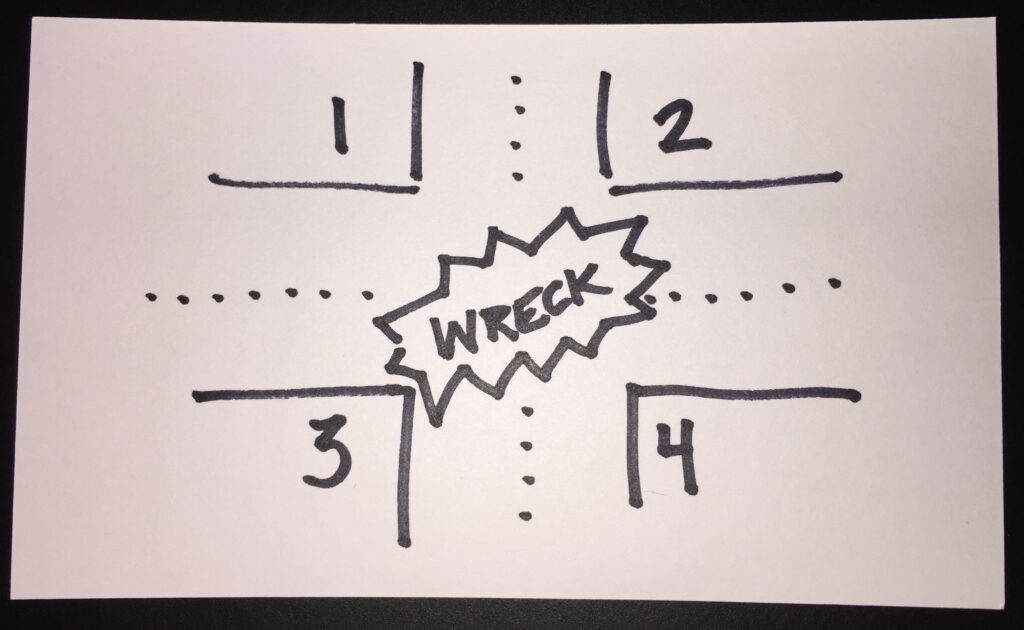Podcast: Play in new window | Download (Duration: 16:50 — 15.5MB)
Subscribe: Apple Podcasts | Spotify | RSS | More
Making decisions.
Solving problems.
It’s THE job of top-level executives and business owners. The higher up the food chain, the more critical the decisions and solutions. Lower level or mid-level decisions have an impact, but they’re not as high risk as those made in the C-suite. Even so, it’s important for an organization to help leaders at every level make wise decisions. Leaders can learn how to do it better. Organizations benefit when leaders advance based on their ability to make great decisions and effectively solve problems quickly.
I often use an index-card illustration with clients.

A car accident happens at an intersection. Four different witnesses, standing at each corner, saw the whole thing. As you investigate to figure out what happened, you have options. You can survey the scene and deduce what happened without talking to anybody. You can speak with the witness standing on corner 1 and draw your conclusions without hearing what witnesses 2, 3 and 4 have to say. You can single out any of the other witnesses to the exclusion of all others, or some of the others. It’s up to you.
The smart investigator will leverage the power of everybody who saw the wreck, including the drivers and passengers of the vehicles involved. There could be lots of people to listen to and understand. The investigator will find great value in anybody who can add credible testimony to help him figure out the truth. We’d consider any investigator who didn’t to be a poor detective.
Unfortunately, some organizations don’t see problem-solving or decision-making inside their operations the same way. Too frequently leaders arrogantly figure they’re the smartest person in the room, fully capable of making the decision without any help or input from others.
The combined insights gained from the four witnesses at the intersection provide the investigator with a more complete picture of what happened. It eliminates potential blind spots that could derail the investigation.
I intentionally titled today’s show using the word “creative” because creativity is a differentiator in high achieving organizations. Yes, they execute better, but they don’t follow the throngs in how they do things. Groupthink doesn’t tend to produce innovative, creative solutions. Of course, groupthink is easier because you simply have to copy cat what others do. Every industry has it and most organizations do things pretty much the same way others in the industry do. Don’t do it. Brace yourself to put in the work to be more insightful and creative. It’s going to require you to learn how to better leverage others.
Step 1 – Commit the time required.
Using my index-card illustration, the investigator could more quickly walk around the scene and decide what happened. He would likely get it completely wrong, but he might get it right. He could save a lot of time.
Taking the time to speak to every witness and carefully surveying the scene will take a lot more time, but the odds of him getting it 100% correct soar.
Realistically, sometimes time isn’t on our side. Sometimes an event or circumstance hits causing us to act now. This is when we have to quickly weigh the consequences – the risks and rewards – of taking more time. In decades of running companies, I’ve almost never been faced with a decision or problem that didn’t allow time to leverage the perspectives of others. I’m a speed freak, but there’s a big difference in being quick to act responsibly and being careless. Don’t be careless. Reckless problem-solving will create more problems than it solves, but I see it happen time and again as executives reach for that box of bandages to temporarily fix some nagging problem…when thoughtful minor surgery might fix the problem once and for all.
Make time to leverage the experience and insights of others who can help you figure out the right move.
Step 2 – Avoid conclusions until you’ve gained those insights.
It drives me crazy to hear an executive speak with somebody on their team prefacing the conversation with the opinion or conclusions they’ve already drawn.
Executive: “I think we should move forward on that, what do you think?”
Team member: “Sure.” (even though they have a very different opinion)
Don’t ruin the testimony you can gain from your team or anybody else who might help you see things more clearly. Open up your mind and you’ll make better decisions faster. It helps to leave yourself open to the possibility that you may not always be right and that things may not always be what they seem. It also helps if you give enough consideration to others, assuming they may know more than you do. Don’t you want to be surrounded by bright, smart people? Then view them that way.
Step 3 – Clarify what you’ve learned and rehearse it with your team.
After the individual talks get your group together – the people who have particular helpful insights about this issue – and rehearse with them what you’ve discovered. Confirm what you’ve learned and see if anybody corrects something you may have misunderstood. Again, it’s important that you avoid reaching a conclusion (or at least that you avoid sharing your opinion). This is where you want to distill what you’ve learned. It’s also smart to ask the group what solution they think they be best. Let them debate it. Facilitate a productive but candid conversation. If you can work to consensus, that’s great – but it’s not always possible.
Step 4 – Don’t assume there’s only one right answer. Put the top ideas on trial for their lives and let the best ones bubble to the top (hopefully, clear for everybody to see).
Make the decision and gain a commitment from the team to help execute the decision. Many a good (or decent, perhaps even great) decisions have been foiled because a team member knowingly or unknowingly sabotaged the decision. Allow no saboteurs on your team. Ever! Not once the decision has been made. This is easier to do when you’ve allowed time for debate, even vigorous debate. Team members are like disgruntled customers. They sometimes just need to vent. Don’t rob them of that opportunity. Sometimes out of that venting come some creative solutions.
Step 5 – Fix it and move forward. Don’t fix it only to revisit it constantly.
This is where creativity really earns its keep. Sometimes you must bandage something to buy yourself more time, but more often than not I see organizations patch up a problem that needs more serious attention. Why? Laziness. They don’t want to devote themselves to the issue long enough to fix it so they can be attentive to other, perhaps more important, things.
If you don’t have time to do it right, then when will you have time to do it over?
Everybody knows that question, but sometimes we still claim we don’t have time to do it right…or time to fix it permanently right now. We’ll get around to it later. But we never do. Meanwhile, the wound starts bleeding again and we grab more bandages. Sometimes I sit down with a CEO who confesses he’s got specific challenges that have gone on for years using that exact strategy. If he’d only dug deeply enough to commit the time and resources to figure this out years ago, the organization would have been further up the road to greater success.
When possible, look for a permanent (I know things can change) solution. A great long-term decision. Don’t add to your daily fires by performing a half-hearted fix.
Refuse to leverage the power of others at your peril. Your competitive edge lies in listening to, understanding and accepting the collective experience, wisdom and insights of the people around you. If you can’t do that, then my question remains, “Why are they surrounding you?”
Be well. Do good. Grow great!
Randy
